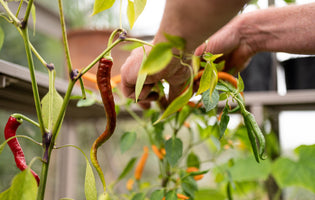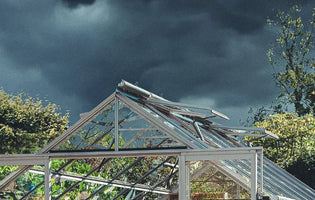There’s something hugely satisfying about growing new plants from seed or from cuttings of other plant species. Known as propagating, it’s not only a fun way of creating an interesting and varied garden, but a cheaper way of multiplying garden and house plants.

Knowing what to propagate, how and when gives you access to a plethora of different plant species from around the world. You don’t even need to have a green thumb to be a successful propagator, as our comprehensive guide on plant propagation shows. We’ve covered different propagation techniques, what factors may influence the success (or not) of growing propagated plants, and some great tips to get you started.
What is plant propagation?
Let’s start by explaining exactly what plant propagation is. In simple terms, it is growing a plant from a seed, or a cutting generated from a parent plant. Although there are various methods of propagation, there are two basic forms – sexual and asexual propagation.
Sexual propagation
This form involves male and female plants to germinate a brand-new plant. This is a natural process that we see every day; just think of how bees and insects go from plant to plant. It starts with a parent plant flowering; those flowers are pollinated and fertilized before the seed is created and goes on to grow into a new plant. For many of this country’s trees, hedges and shrubs, and other species in the wild, this is the normal, or only, form of propagation. Generally, the new plants are stronger and more resilient than their parents, too. Another advantage is that the seeds can be cultivated, stored for long periods and transported easily, which many people buy in packets.
Asexual propagation
This form involves growing new plants from the roots of parent plants, like tubers and bulbs, but also from its leaves, stems and branches. The difference is that it only needs one parent plant instead of two, so the new plant will be identical to its parent. The most common ways to propagate plants this way is through cuttings, grafting or budding, and layering – more about this later. An advantage of this method is that propagation is quicker as there is no pollination, fertilization or seed generation. But it will retain its parents' DNA and can be used to repair or even recover damaged plants.
Techniques of plant propagation
There are a variety of plant propagation techniques for growing new plants, some of which are easier than others, and some are affected by outside influences. These are the most common ones.
Seed propagation
This technique is familiar to gardeners and non-gardeners alike as we have all seen seeds sold in garden centers and other stores. A huge range of plants can be grown from seed; indoors, outdoors and in greenhouses. Some seed varieties must be germinated in warm, protected conditions, while others can be sown straight into the ground outside. The genetic makeup of the seed means it takes a while to produce mature plants like wisteria.
Cuttings
A cutting is a piece of leaf, stem or branch which is snipped off the parent plant and rooted in soil or compost to grow a new plant. Many gardeners will use a rooting medium, such as a hormone powder, to aid germination or cut the tip and put it in water until the roots appear, then transfer it to a pot.
Stem cutting
There are different types of cuttings; the first is stem cuttings, which are best for plants with a woody stem, like roses, azaleas and other shrubs. Cut a 10-15cm length of stem from the parent plant, and place it in soil mixed with compost, vermiculite, or peat. You can use a rooting powder, but you can also put it in water until the roots appear before potting it out in a pot or a bed in the greenhouse. Try to cut the stem from new growth on the parent plant to create strong roots.
Leaf cutting
Similar to stem cutting, you can also use the leaves of parent plants to create new ones. There are two types of leaf cutting depending on the plant species. In many cases, you can take the whole leaf and its small stem, dip it in a rooting powder and place it in compost until it roots. You can also leave the leaf’s stem submerged in water until the new roots start coming through. However, for some plants, you should make a small slit in the leaf’s vein(s) and then lay the leaf with the slit downwards over the rooting compost. This method does take a bit longer for germination to occur.
Division
Many garden plants with spreading or clumping tendencies, like grasses and ferns, grow a bunch of stems from the parent, and each stem has its own roots. At the right time of the year, the parent plant can be lifted, and these stems separated. They can then be planted individually, and the parent plant replanted. Many of the stems can be gently pulled away from the parent, but you may need to use a spade to separate other more robust stems.
Layering
A bit more complicated than the above methods, there are various layering types, such as air, mound, tip, compound and simple layering, but the process is more or less the same.
Essentially, it is the method of making a small slit, cutting a piece of the stem of the parent plant but leaving it attached, and manipulating it, i.e., bending it gently to reconnect or bury it into a rooting compost. Once the roots have developed on the stem and are firmly established, they can be separated from the parent and replanted.
Factors influencing propagation success
A wide range of factors will influence how successful the propagation is, such as the weather and time of year.
Timing
The time of year has a big impact on propagation. Most plants will respond better when they are in their active growing period. This will be different for winter and summer flowering plants, but as a general rule, softwood cuttings should be taken from mid-spring through to early summer. Hardwood cuttings are more successful when taken from mid-autumn to mid-winter. However, you can take cuttings at any time of the year if you have a greenhouse and can control factors like temperature.
Temperature and humidity
Make sure your cuttings have the best start by giving them their optimal temperature and humidity conditions. To do this, you can use propagators, some of which are electric and provide the right level of heat, plastic covers, misting systems, rooting systems, seeding mats, lightboxes and greenhouse heaters.
Medium and watering
Two other factors that will improve propagation success are the rooting medium and water. Make sure you choose a growing medium, whether that’s well-drained soil, a sterile rooting mix or compost specifically for propagation, with all the correct nutrients.
Watering is just as important as you don’t want to drown the cuttings but remember they are young plants and may need watering more often.
Hormones and rooting aids
Some plants will grow roots fairly quickly in just water or a rooting compost, but others will need some help. Rooting hormone powder, which is also available as a liquid or gel, and other growth-promoting products, like organic products, will help to boost root generation and growth, thereby increasing propagation success.
Tips for successful propagation
Whether you are just starting out or a seasoned gardener, propagating plants is not always easy, but it is hugely satisfying. Here are some tips to help you with propagation success.
Start with easy plants
If you’re just starting your plant propagation journey, start with plants that are easier to propagate from cuttings, like herbs, succulents and some varieties of houseplants. When you’ve mastered those, and become more confident with propagating methods and tools, experiment with other, more challenging plants.
Take healthy cuttings
Before taking a cutting, water the parent plant the night before so the stems are filled with water. If possible, take your cutting in the morning from a healthy, disease-free plant. Make sure you make a clean-cut using tools that are sharp and free from rust or dirt. Before you place it in the rooting medium, remove any leaves likely to sit below the soil line to prevent rotting.
Patience and persistence
If it doesn’t work at first, don’t give up; propagating plants takes patience, time, trial and error. Some plants aren’t easy to propagate, and your first efforts may not root well or survive. Learn from your experiences and try out different techniques to get good results.
A great way to start propagating and be successful is to invest in a greenhouse, which will help you create the right environment for your propagated plants.







